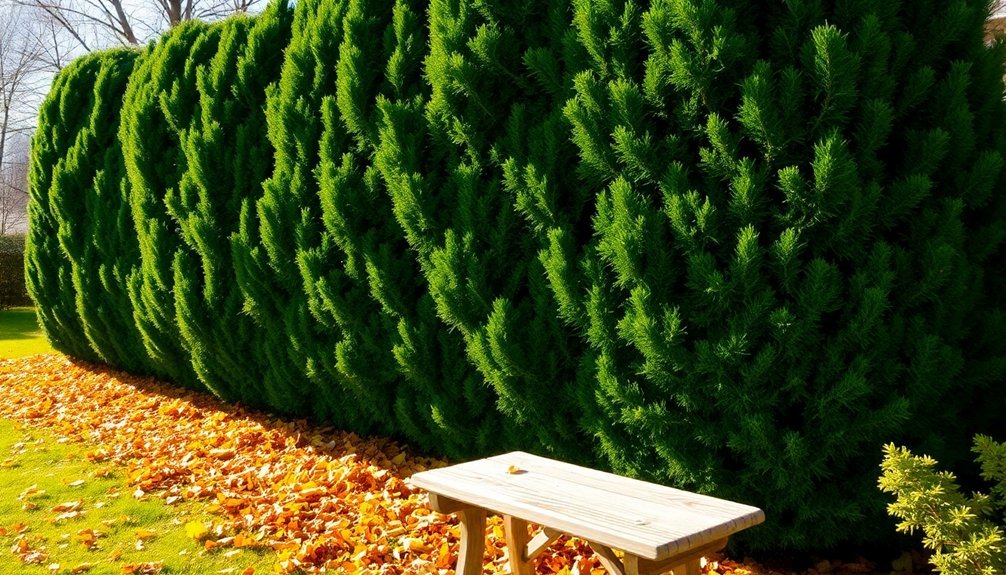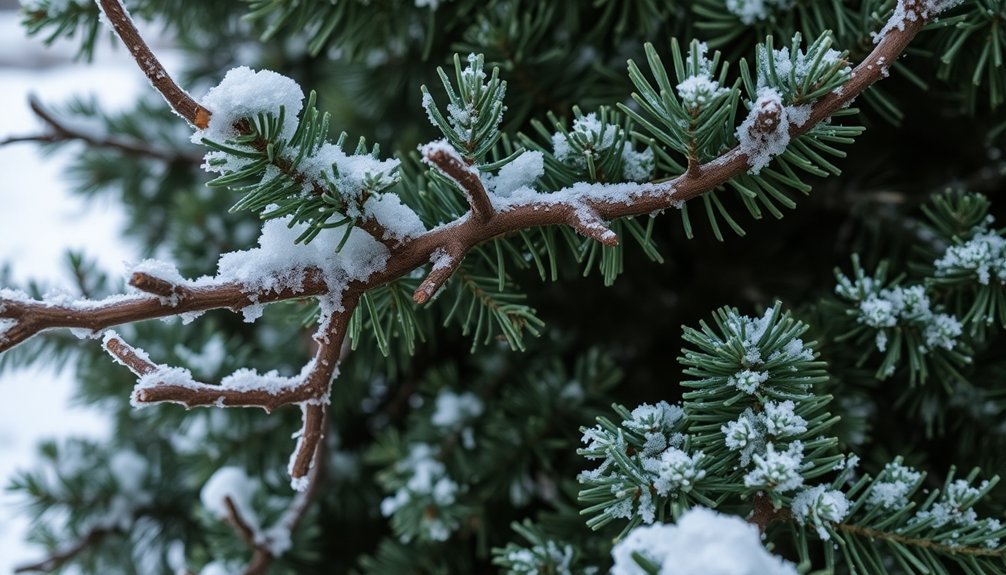Maintain your evergreen screen's health year-round with seasonal care. Prune in late winter before new growth begins, shape with sharp shears in early summer, and thin selectively in late summer to improve air circulation. Water deeply in fall before ground freezes, apply mulch for winter protection, and remove heavy snow from branches to prevent breakage. Conduct damage assessments in spring to catch issues early. These seven timing strategies will transform your privacy hedge into a standout landscape feature.
7 Seasonal Tips for Shaping Evergreen Screens

While maintaining the perfect evergreen screen requires year-round attention, understanding seasonal care tactics will greatly improve your results. Each season demands different approaches to pruning, watering, and protection.
Creating a beautiful privacy screen is a four-season commitment with specific maintenance tasks for each time of year.
In summer, focus on daily watering for newly planted trees, using drip irrigation systems with timers for efficiency. You can perform minor pruning touch-ups, but save major reshaping for later. These advanced irrigation methods minimize water waste while ensuring roots receive adequate hydration.
Fall is ideal for tool preparation and soil enrichment through fertilization, which strengthens roots before winter.
When winter arrives, protect your screens from heavy snow by gently brushing it off branches. Increase mulch thickness to insulate roots. Wait until late winter or early spring for significant pruning work.
For long-term success, remember that fast-growing varieties may need monthly trimming during growth seasons to maintain their shape.
Spring Renewal: Preparing Your Living Barrier for Growth Season
Your evergreen screen needs attention after winter dormancy, beginning with a thorough damage assessment to identify any frost-killed branches or pest issues.
Prune before the spring growth surge starts, removing dead wood and selectively thinning crowded areas to improve air circulation and light penetration.
Considering the risks of monoculture plantings, spring is an ideal time to introduce new plant varieties to create a more mixed screen that will be more resilient against pests and diseases.
You'll set your living barrier up for robust seasonal growth by addressing these maintenance tasks early, ensuring a denser, healthier screen throughout the coming year.
Prune Before Growth Surge
Preparing evergreen screens for their seasonal growth surge requires strategic timing and proper technique. For most evergreens, late winter to early spring provides the ideal pruning window, just before new growth emerges.
Your narrowleaf varieties like junipers and arborvitae offer flexibility, tolerating pruning from April through September. However, pines and spruce should wait until after their spring flush, typically around May. When working with pines, be sure to cut new shoots or candles back by half to maintain proper density and shape.
Always use hand clippers for precise shaping rather than shears when detail matters. Remember to maintain your evergreen's natural form while removing dead or diseased branches.
For yews, avoid cutting into dead zones where regrowth won't occur. By pruning before the growth surge, you'll allow your evergreen screen to recover quickly and develop a fuller, healthier appearance throughout the growing season.
Selective Early Thinning
Selective early thinning revitalizes evergreen screens and prepares them for vigorous spring growth. As winter dormancy ends, identify branches that need removal to create a more natural appearance while maintaining your screen's density.
For randomly branched varieties like junipers and arborvitae, make thinning cuts to enhance their layered look, but avoid cutting into bare wood since these species won't resprout from such areas. This is an ideal time to apply acidic fertilizers to support their overall health during the growing season.
If you're working with whorled branchers like pines or spruces, focus on selecting a strong central leader and removing competing leaders to improve structural integrity.
You'll get best results by thinning before the major spring growth flush. Remove select branches to control size while encouraging new growth in preferred directions.
This approach maintains your screen's health while achieving a more aesthetically pleasing form than harsh shearing would provide.
Post-Winter Damage Assessment
As winter's grip loosens, thorough damage assessment of your evergreen screens becomes essential for spring renewal success.
Begin by inspecting each plant for signs of fungal infections, pest activity, and physical damage from snow and ice accumulation.
Look closely at your evergreens' coloration—yellow or brown patches might indicate nutrient deficiencies requiring immediate attention.
Don't overlook the soil conditions; compacted soil restricts root growth and requires aeration.
Take detailed photos before you begin any remediation work. These visual records will help you track improvements throughout the growing season and inform your maintenance strategy.
This documentation proves invaluable when analyzing past challenges and developing more effective care routines.
Your careful assessment now will set the foundation for healthy, vibrant evergreen screens through the upcoming seasons.
Consider replenishing mulch around the base of your evergreens to promote moisture retention and support recovery from winter stress.
Early Summer Shearing: Controlling the Shape of Dense Evergreens
The ideal window for shearing evergreen screens arrives in late spring to early summer, when plants are primed for controlled growth. This timing allows new growth to harden before winter sets in, protecting your investment from cold damage.
For best results, use sharp, clean shears that make precise cuts without tearing plant tissue. Remember to maintain the natural shape of your evergreens, keeping the base slightly wider than the top to guarantee sunlight reaches all foliage. This approach prevents interior dieback and promotes denser growth. Selective pruning with secateurs rather than mass shearing creates a more natural appearance while still maintaining control over size.
Different species require specific attention—pines should be pruned when new needles are half the size of mature ones.
While hand shears offer cleaner cuts than electric options, your choice should balance precision with efficiency for your screen's size.
Midsummer Maintenance: The Best Time for Needle-Bearing Species

Contrary to popular belief, midsummer marks a crucial period when you should avoid pruning needle-bearing evergreens altogether.
Heat stress combined with pruning can severely damage your plants, making recovery difficult and leaving them vulnerable to winter injury.
Instead, use this time for careful monitoring. Watch for signs of Rhizosphaera needle cast—yellow discoloration turning reddish-purple—or pest damage from beetles and mites. If you notice webbing on branches, you likely have spider mite infestations that require immediate attention.
Normal needle drop occurs, but spiral patterns may indicate root issues.
Save your pruning for late winter to early spring when plants are dormant. This timing promotes dense growth and allows new shoots to harden off before winter arrives.
For winter protection, focus on newly planted specimens rather than established needle-bearing varieties, which rarely require burlap screens.
Late Summer Thinning: Improving Air Circulation and Health
While needle-bearing evergreens need minimal disturbance during midsummer, late summer presents an opportunity for strategic thinning of broadleaf varieties to boost overall health. Thinning improves air circulation, which prevents moisture buildup and reduces disease risk. You'll also encourage better sunlight penetration and maintain structural balance. Remember that wound dressing is unnecessary when making proper pruning cuts, as trees have natural healing mechanisms.
| Thinning Focus | Benefit | Technique |
|---|---|---|
| Dead branches | Prevents disease spread | Use disinfected tools |
| Crowded areas | Enhances air flow | Three-cut method |
| Weak limbs | Reduces snow damage | Avoid collar cuts |
Fall Preparation: Protecting Your Screen Before Winter

You'll want to clear away any dead growth from your evergreen screen by early fall to prevent diseases from taking hold over winter.
Take this opportunity for gentle spot pruning of damaged branches, which helps the plant focus energy on healthy growth during dormancy. Watering thoroughly in autumn is essential as it replenishes moisture that evergreens will need to survive winter's drying effects.
Before freezing temperatures arrive, implement winter protection measures like deep watering, applying mulch around the base, and considering burlap wraps for screens in exposed locations.
Clean Up Dead Growth
As autumn leaves begin to fall, preparing your evergreen screen for winter becomes essential for its long-term health and vigor.
Start by removing fallen leaves from around your evergreens to prevent moisture buildup that can lead to disease.
Prune dead branches that might break under heavy snow, and inspect your screen carefully for signs of pests or disease that should be treated before winter sets in. Make sure to trim weak branches from your evergreen shrubs to improve their structure and prevent winter damage.
Apply a 3-4 inch layer of coarse mulch around the base of your evergreens to insulate roots from temperature fluctuations.
For sensitive varieties, consider wrapping them in burlap or protective netting to shield against drying winter winds.
Don't forget to water thoroughly before the ground freezes to guarantee your evergreens have enough moisture to sustain them throughout the dormant season.
Gentle Spot Pruning
Gentle spot pruning represents a key final step in preparing your evergreen screen for winter's challenges. Use sharp bypass hand shears to make precise cuts just above well-formed buds, focusing on small areas to maintain plant structure without compromising winter hardiness.
Timing is essential—avoid late fall pruning as it stimulates vulnerable new growth that won't harden before freezing temperatures arrive. Instead, save major pruning for early spring and limit your fall work to:
- Removing broken or diseased branches that could become entry points for pests
- Lightly thinning dense areas to reduce snow load and wind damage
- Pruning according to your evergreen type (whorled vs. random branching patterns)
- Supporting structural integrity by maintaining a strong central leader
Consider using tools that are clean and sharp to prevent disease transmission between plants while making these limited fall adjustments.
Winter Protection Measures
Preparing your evergreen screen for winter's challenges requires thoughtful protection measures implemented before the first frost.
Deep water your evergreens a few weeks before ground freeze, focusing on the root area to prevent dehydration.
Apply 2-4 inches of organic mulch around the base, keeping it away from trunks to insulate roots and retain moisture.
Install burlap screens on the windward side using wooden stakes to shield plants from drying winds.
For smaller evergreens, consider adding support stakes on opposite sides of the tree and secure with soft twine to prevent winter storm damage.
For additional protection, spray anti-desiccants like Wilt-Pruf on dry days when temperatures are above freezing.
During winter, gently brush heavy snow from branches to prevent breakage, but leave snow around roots for natural insulation.
Consider planting hardy varieties in sheltered locations to minimize winter damage long-term.
Winter Inspection: Identifying and Repairing Storm Damage

When winter storms strike, your carefully maintained evergreen screens face multiple threats that can compromise both their appearance and structural integrity.
Conducting thorough inspections using binoculars will help identify damage that requires immediate attention.
Watch for these common winter injuries:
- Ice accumulation damage – Remove broken branches promptly to prevent further structural stress.
- Wind-related issues – Stabilize uprooted young trees with stakes until they regain stability.
- Snow load pressure – Gently brush heavy snow from branches before they bend or break.
- Critter damage – Inspect trunks for rodent activity, which increases during harsh winters.
For severe damage, don't hesitate to consult a certified arborist. Early detection of structural weaknesses can prevent catastrophic failures during winter storms.
Apply anti-desiccant sprays to vulnerable foliage to prevent moisture loss and reduce winter burn on your valuable screens.
Frequently Asked Questions
How Do I Transition From a Hedge to a Natural Screen?
You'll need to gradually replace hedge plants with diverse native species. Plant them in staggered clusters, maintain proper spacing, prepare soil thoroughly, and add mulch. Be patient as your natural screen develops over time.
Can I Mix Evergreen Species in a Single Screen?
Yes, you can mix evergreen species in a single screen. It'll enhance aesthetic appeal, create layered structure, support biodiversity, provide wildlife habitat, and offer year-round visual interest with varying textures, colors, and growth habits.
How Do I Repair Large Gaps in My Evergreen Screen?
To repair large gaps in your evergreen screen, identify gap size, plant fast-growing species 3-4 feet apart, use staggered arrangement, and consider temporary screens while new plants mature. Don't forget proper mulching and watering.
Will Pruning Stress My Evergreens During Drought Conditions?
Yes, pruning will stress your evergreens during drought. You'll increase their vulnerability to diseases and pests. Only remove dead or damaged branches, avoid heavy pruning, and wait until late winter if possible.
How Close to Utilities Can I Safely Plant Screen Trees?
Keep small trees (under 20 feet) at least 20 feet from power lines. Plant larger trees 40-60 feet away. You'll need to maintain clearance for utility crew access and call 811 before digging.
In Summary
By following these seasonal tips, you'll maintain a beautiful, healthy evergreen screen year-round. Remember, timing is everything—spring renewal, summer shaping, fall preparation, and winter vigilance each play essential roles. Don't forget to use proper tools and techniques for your specific evergreen varieties. With consistent care, your living privacy barrier will thrive for years, providing the secluded, green sanctuary you've been wanting.





Leave a Reply